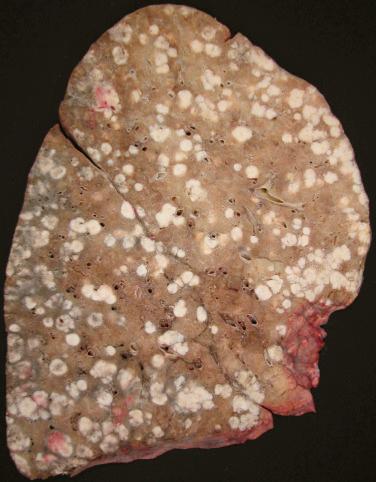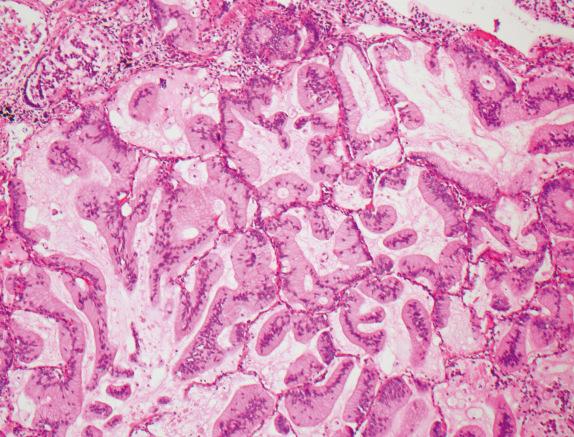Physical Address
304 North Cardinal St.
Dorchester Center, MA 02124
Metastases to the lung are the most common malignancy, with incidence ranging from 30% to 55% in various series. This is not surprising because the entire cardiac output and lymphatic fluid produced by the body flow through the pulmonary vascular system. If direct invasion of lung and trachea is included, then the incidence is even higher. In autopsy series, the most common primary sites with pulmonary metastases include breast, colon, kidney, uterus, and head and neck ( Table 29.1 ). With improved survival of patients with malignancies and an increasing number of palliative surgeries, metastatic disease to the lung in bronchial and surgical specimens is growing. With the advent of targeted therapies, distinguishing metastases from primary lung tumors is critical.
| Primary Tumor Site | Frequency at Presentation/at Autopsy |
|---|---|
| Urologic: Kidney Bladder Prostate |
5%–70%/50%–70% 5%–10%/15%–30% 5%–25%/15%–55% |
| Gynecologic Uterine Cervix Endometrium Ovary |
15%/20%–30% 2%–5%/20%–40% 3%–5%/20%–45% |
| Gastrointestinal Colorectum Gastric |
5%–20%/10%–30% 5%/20%–30% |
| Head and Neck | 5%/10%–40% |
| Breast | 5%–25%/60% |
| Thyroid | 4%–10%/50%–65% |
| Melanoma | 5%/50%–80% |
| Choriocarcinoma | 50%/70%–100% |
| Osteosarcoma | 10%/75% |
| Testis | 5%–15%/70% |
| Lymphoma Hodgkin Non-Hodgkin |
9%/22%–62% 5%/25% |
Metastatic disease to the lungs can occur by different mechanisms, and each route is usually associated with characteristic clinical, radiologic, and pathologic features, although overlap is frequent ( Table 29.2 ). Direct extension of the tumor usually occurs from a contiguous neoplasm or from direct intravascular involvement. This mechanism, less common than true metastases, is usually seen with primary thymic, esophageal, or thyroid neoplasms invading directly into lung or trachea. Rarely, direct extension to the lung occurs via the vasculature, such as renal cell carcinomas or germ cell tumors invading the inferior vena cava into the right heart then extending into pulmonary arteries. True metastases can be defined as viable tumor cells transported from one site to another. They occur due to tumor spread via the vasculature, commonly the pulmonary arteries, and also the lymphatic vessels and bronchial arteries. The pulmonary arteries are the most common route of tumor spread to the lung. The mechanism of metastasis is a complex multistep process in which cells must acquire the capability of invading into and migrating through the extracellular matrix into the vasculature, disseminating through the vessels, avoiding destruction by the immune system, and then forming secondary deposits. Therefore few metastases are produced, despite millions of cells being released into circulation. In the lung, this process usually results in tumor emboli. Although the emboli may be large, the majority are small, involving the small arteries and arterioles. The fate of the embolized tumor cells is variable, but occasionally, growth through the vasculature into the surrounding lung parenchyma, with formation of a nodule, occurs. In some instances, the tumor cells remain confined to the vasculature and spread diffusely through the vascular channels, including lymphatic vessels. Metastases via bronchial arteries are thought to be much less common and can result in endobronchial metastases. Spread of tumor via lymphatic vessels can arise after the occurrence of tumor emboli with invasion into adjacent lymphatic vessels or by retrograde spread into lymphatic vessels, followed by dissemination to hilar and mediastinal lymph nodes. Occasionally, tumor cells can be liberated into the pleural space and transported by the pleural fluid to a site of implantation. This pleural focus may originate by direct extension or via lymphatic or blood vessels. Tumor dissemination through the airways is poorly understood and probably rare, thought to occur primarily with mucinous adenocarcinoma (see Tables 29.3 and 29.4 ).
| Direct Extension |
| Vascular Pulmonary arteries Bronchial arteries Lymphatic vessels |
| Pleural space |
| Airways |
| Common | Uncommon |
|---|---|
| Nodules: Multiple “canon-ball” |
Nodules: Solitary Miliary Cavitary Calcified Cystic with spontaneous pneumothorax |
| Pleural effusion | Lymphangitic carcinomatosis with interstitial thickening |
| Pulmonary hypertension and infarct | |
| Airway obstruction with obstructive pneumonia/atelectasis. | |
| Alveolar hemorrhage syndrome |
| Cystic nodule | Sarcoma: Endometrial stromal sarcoma Leiomyosarcoma |
| Miliary nodule | Carcinoma: Thyroid (medullary) Prostate Pancreas Melanoma |
| Cavitary nodule | Carcinoma: Colon Head and neck Cervix Osteosarcoma |
| Calcified nodule | Carcinoma: Thyroid (papillary) Colon Sarcoma: Osteosarcoma Chondrosarcoma |
| Solitary nodule | Carcinoma: Kidney Breast Colon Urothelial Melanoma Osteosarcoma |
| Lymphangitic carcinomatosis | Carcinoma: Breast Stomach Pancreas Prostate Lymphoma |
| Tumor embolus | Carcinoma: Kidney Stomach Liver Breast Sarcoma (origin from large vessels) Choriocarcinoma |
| Endobronchial mass | Carcinoma: Breast Kidney Colon Melanoma Sarcoma Thymoma |
| Pleural effusion/metastasis | Carcinoma: Breast Ovary Gastric Lymphoma |
| Diffuse pulmonary hemorrhage | Angiosarcoma Choriocarcinoma |
Often asymptomatic
Symptoms include shortness of breath, cough, wheezing, hemoptysis, and chest pain
Unusual presentations include pneumothorax, emboli with infarct, pulmonary hypertension with cor pulmonale, airway obstruction, and diffuse alveolar hemorrhage
Commonly multiple nodules without lymphadenopathy
Miliary pattern, calcification, cavitation, cystic lesions, interstitial infiltrates, endobronchial, and solitary nodule are rare manifestations
Well-circumscribed and variable-size nodules most common finding
Other features include:
Lepidic growth pattern mimicking adenocarcinoma in situ
Thickening of interlobular septa, peribronchovascular, and subpleural connective tissue by tumor with prominent desmoplastic response
Tumor emboli with intravascular clusters of tumor cells admixed with fibrin
Alveolar hemorrhage with discrete perivascular tumor nodules
The most common manifestation of metastatic disease to the lung consists of multiple nodules, usually derived from small tumor emboli with secondary extension into the adjacent lung parenchyma. Of patients with multiple metastases, 80% to 90% have a previous history of malignancy or are diagnosed with a synchronous primary. Patients are usually asymptomatic (75%–90%), but when present, symptoms are related to the growth and location of the nodules. These most often include cough, hemoptysis, and wheezing. Extension into pleura and chest wall can lead to chest pain or Pancoast syndrome. Spontaneous pneumothorax is an uncommon presentation of pulmonary metastasis, accounting for less than 1% of patients in one large series, and most commonly recognized in patients with osteosarcoma, soft tissue sarcoma, and endometrial stromal sarcoma. Some patients may have predominantly cystic lesions without developing pneumothoraces. Although uncommon, multiple pulmonary cysts or spontaneous pneumothorax may be the first manifestation of metastatic disease in patients with known malignancy.
The most sensitive imaging modality currently available to evaluate patients with multiple lung nodules is computed tomography (CT) scan. Helical CT scan is perhaps more sensitive than high-resolution CT scan, in particular for lesions less than 0.6 cm. Despite its sensitivity, because up to 60% of metastases are reported as 0.5 cm or less, CT scan can underestimate the burden of metastatic disease. Also, CT scan is not entirely specific because nodules can consist of granulomas or other benign processes. Positron emission tomography scanning may aid in assessing the malignant potential of lung nodules. However, its usefulness is limited to nodules that are greater than 1 cm and solid, and false positives may occur, especially with granulomatous disease.
Metastatic tumor nodules are multiple in the majority of cases, ranging in size from hardly visible to large growths capable of occupying an entire lung, with an average size of 1.0 to 2.0 cm. Mediastinal and hilar nodes are usually not enlarged. Pulmonary metastases are most commonly found in the outer third, subpleural regions of the lower lung zones (lower lobes affected in 37% vs. upper lobes in 21%). Rarely, the deposits are minute and numerous in a miliary pattern. This pattern has been described with medullary carcinoma of the thyroid, malignant melanoma, and prostatic carcinoma, among others. Cavitation has been reported in 4% of metastases and occurs less commonly than with primary lung cancer. It has been described in metastatic squamous cell carcinoma, mainly from the head and neck or cervix, adenocarcinoma of the colon, and osteosarcoma. Calcification of metastatic lesions is rare and usually occurs in neoplasm with matrix production such as osteosarcoma or chondrosarcoma. It has also been described in neoplasms with psammoma bodies such as papillary carcinoma of the thyroid, or through dystrophic calcification of mucin in mucinous adenocarcinomas from the colon or another primary site. When calcified metastatic lesions are small, they can mimic benign lesions such as calcified granulomas.
Metastatic neoplasms presenting as a solitary nodule are uncommon, accounting for 1% to 5% of all lung metastases and 2% to 10% of solitary pulmonary nodules. Neoplasms most likely to result in a solitary metastasis are carcinoma of the colon, kidney, and breast, sarcomas (particularly osteosarcoma), and malignant melanoma.
Parenchymal nodules are usually well circumscribed and of variable size ( Fig. 29.1 ). Occasionally, they can be approximately equal in size, possibly representing a single embolic shower. The size of the cavities in cavitary metastases is often variable, ranging from less than 1.0 cm to over 6.0 cm, and the walls are shaggy and thick, measuring between 0.3 and 2.5 cm. Blood, necrotic material, and rarely fungus balls can be identified. Communication with the adjacent bronchial tree is occasionally present. In cystic metastases, the wall is usually very thin—less than 0.3 cm—smooth, and the cavity filled with air.

Parenchymal nodules are usually located adjacent to pulmonary arteries and arterioles. Small tumor emboli can be identified, and parenchymal growth is usually destructive, forming a relatively well-circumscribed nodule, composed of a variable proportion of viable and necrotic tumor and reactive stroma. Rarely, the growth pattern is lepidic, along intact lung architecture, mimicking adenocarcinoma in situ ( Fig. 29.2 ). This growth pattern is seen mainly in carcinomas of the colon and the pancreaticobiliary system. In cavitary lesions, vascular invasion in the vicinity of the metastasis is a common finding. The walls of cavitary or cystic lesions can be a mixture of tumor and stroma, and occasionally, the tumor can be difficult to identify.

Lymphangitic carcinomatosis is an uncommon pattern of tumor spread, occurring in less than 10% of pulmonary metastases and can mimic interstitial lung disease clinically and radiologically. It usually occurs as a result of hematogenous spread, with involvement of the interstitial space and then the lymphatic vessels, or retrograde from the lymph nodes toward the periphery. Thus it can be seen in any metastatic neoplasms, but the most common ones include breast, stomach, pancreas, and prostate. Symptoms include dyspnea, typically with an insidious onset, yet rapidly progressing over a few weeks.
The CT scan appearance is characterized by smooth-to-nodular thickening of the interlobular septa and peribronchovascular interstitium, usually with preservation of the underlying lung parenchyma. The thickening is usually asymmetric. Associated pleural effusion is present in up to 30% of patients and hilar or mediastinal enlargement in up to 40%.
Become a Clinical Tree membership for Full access and enjoy Unlimited articles
If you are a member. Log in here